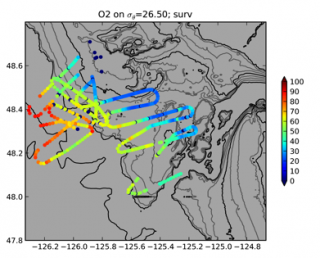After nearly two weeks criss-crossing the shelf and beyond off Vancouver Island, the team is now safely back to Victoria, where the ship’s crew is quickly preparing for the expedition’s second leg with the ROPOS remotely operated vehicle.

“This was a most amazing and highly productive cruise,” says Richard Dewey, Leg One’s chief scientist, “It was certainly one of the most productive any of us have been involved with.”
Yesterday (Friday) the team completed a final, long MVP survey to the northwest, where they wanted to get a final snap shot of what the waters along the continental shelf break were doing. Dewey believes the waters in this region, specifically the shelf front and the way it approaches and interacts with water on the continental shelf off southern Vancouver Island, may be one of the most interesting findings for the cruise.

All told, the team has pulled the MVP nearly 2,500 kilometers (see map at right), and it also proved to be the MVP–most valuable player–for cruise equipment. There were ten full surveys, each lasting from 12 to 40 hours and including hundreds of individual drops to the bottom and pulls back up, or profiles. For all those countless hours, three people had to be diligently watching the MVP system displays to make sure everything was functioning properly and, most importantly, to make sure the heavy “fish” units didn’t hit bottom.

Dewey and his colleagues expect to write at least 3 papers based on the cruise results, and possibly 2 or more others. But, he says the full legacy of the work will be larger. Based on the work completed those aboard are already thinking about multiple new experiments and asking new questions that could guide research for years to come.
“We are all impressed with what you’ve done already on the ship,” says Dewey, “And it’s only been in service for a year.”
